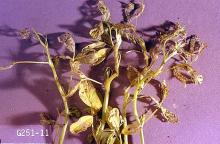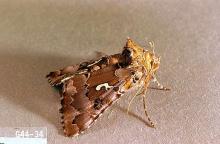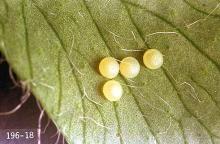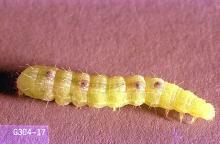Primarily alfalfa looper (Autographa californica)
Pest description and crop damage Alfalfa looper is native to the PNW. The adult is a gray moth with a wingspan of about 38 mm. Mature larvae are about 25mm in length and are dark olive-green with a lighter head. They move in a looping fashion. They are general feeders and, in addition to potentially causing damage to alfalfa fields, they feed on other forage crops, cereals, weeds, berry crops, vegetables, ornamental and woodland trees and shrubs. The larvae feed on leaves, causing ragged-edge holes in the leaf and on the leaf margins. More importantly, they may contaminate mechanically harvested berries.
Biology and life history Alfalfa loopers overwinter as pupae either in the soil or in organic debris near the base of host plants. Moths begin emerging in late spring and adults lay eggs singly on weed hosts (mostly brassicas). Eggs hatch in 3 to 5 days and larvae feed for about two weeks before pupating in cocoons on the host plant or in organic debris. Adults emerge in about seven days (total development time from egg to adult requires about 30 days). Once adults emerge, they mate, and females deposit eggs as before, about three days after emerging. Damage is most evident in June and July, and again in September and October. There are three or four generations each year.
Management-biological control
Many predators and parasites combine to substantially maintain looper populations at low levels. The eggs and small larvae are attacked by bigeyed bugs, minute pirate bugs, and other predators.
Management-cultural control
Larvae can be hand-picked if found.
Management-chemical control: HOME USE
- azadirachtin/neem oil-Some formulations are OMRI-listed.
- bifenthrin
- esfenvalerate
- permethrin-For use on raspberry only.
- plant essential oils (garlic, peppermint, rosemary)-Some formulations are OMRI-listed for organic use. For use on blackberry only.
- pyrethrins-Some formulations are OMRI-listed for organic use.
- spinosad-Some formulations are OMRI-listed for organic use.
- zeta-cypermethrin
Management-chemical control: COMMERCIAL USE
- azadirachtin (Aza-Direct and others)-Consult label for rate. PHI 0 days. Some formulations are OMRI-listed for organic use.
- Bacillus thuringiensis (Bt) (several brands)-Consult label for rate. PHI 0 days. Do not use DiPel ES with captan fungicide; the mixture will bronze foliage. Some formulations are OMRI-listed for organic use.
- Beauveria bassiana (Mycotrol and others)-Consult label for rate. PHI 0 days. Repeat applications every 5 to 10 days unless pressure is high, then apply every 2 to 5 days.
- Burkholderia spp. (Venerate XC)-Consult label for rate. PHI 0 days. OMRI-listed for organic use. Do not apply during bloom.
- Chromobacterium subtsugae (Grandevo CG, Grandevo WDG) at 0.3 to 0.9 lb ai/A. PHI 0 days. Toxic to bees; do not apply during bloom.
- fenpropathin (Danitol) at 0.2 to 0.3 lb ai/A. Must be used as a tank mi with Dipel DF. See label for instructions. PHI 3 days. Highly toxic to bees. Restricted use pesticide.
- pyrethrins (PyGanic) at 0.014 to 0.05 lb ai/A. PHI 0 days. Some formulations OMRI-listed for organic use. Do not apply when bees are actively foraging.
- spinetoram (Delegate WG) at 0.05 to 0.09 lb ai/A. PHI 1 day.
- spinosad (Success) at 0.062 to 0.1 lb ai/A. PHI 1 day. Use higher rate for larger larvae or severe infestations. Toxic to bees for three hours following treatment. Do not apply when bees are foraging.
- tebufenozide (Confirm 2F) at 0.12 to 0.25 lb ai/A. PHI 14 days. Do not apply more than 1.0 lb ai/A per year.





